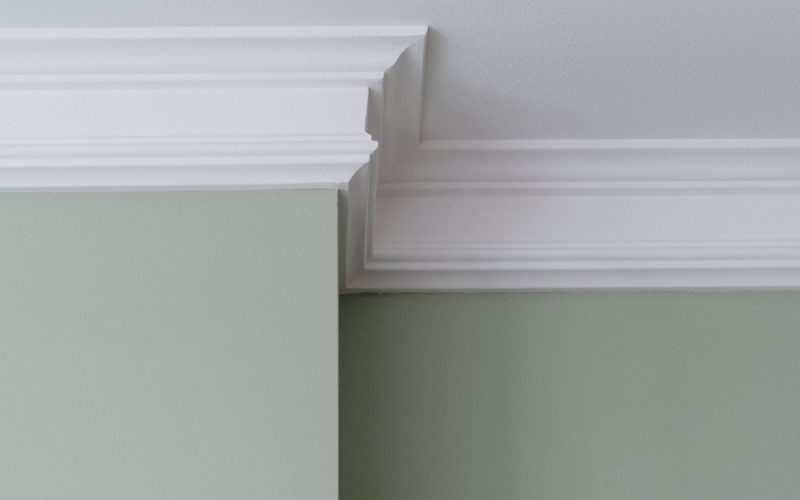Did you finish building your dream house, and all that is left is to give it some decorative finish touches?
Or are you just a curious person on the internet who wants to know about the different trim types and what it entails? Then this article is for you.
There are several trim types in numbers, and keeping track of them can become confusing. But this article is a simple guide to some basics on each type.
Every day, we spend hours surrounded by trim or molding. We might also admire them without even knowing what they are.
It is normal not to notice it immediately, but the different types of trims have become one of the main features that accentuate your home’s interior and sometimes exterior.
They protect and decorate walls and floors and can be installed to help create a classic and elegant design.
Below in this article, we’ll attempt to distill necessary information on what a trim is, materials for making trims, and the different types of trims that exist so that you have enough options during installation to suit your home best for the perfect finishing and much more.
What is a Trim?
Trim, also known as “molding” or “casing,” is a type of millwork used on walls for decorative and practical purposes.
It is an additional decoration typically at the edges and surfaces of walls.
Materials for Making Different Types Of Trims
Despite your taste for home designs, you might also be picky about the materials used.
Luckily, trims and moldings are not restricted to a single type of material.
They can be made from materials like:
- Woods are traditional materials, and they come in many different designs. There are two main types of wood: hard and softwood. Softwoods usually come pre-primed, making them easy to match with existing colors. Hardwoods, on the other hand, mainly add a bit of warmth or charm to where they are installed.
- Polystyrene is a foam-based material that is cheaper than some other types. It is also not very complex to install, but it is delicate.
- Polyurethane is a lightweight material made of rubber and plastic. Its unique structure makes it very flexible, even for bending. Unlike wood, it is irresistible to moisture and rotting.
- Plaster: they are heavy materials. They are for more opulent interiors. It is also usually more expensive.
- PVC ( polyvinyl chloride) is a most commonly used thermoplastic material. It is naturally white.
- Some other materials also include stones and composite materials.
Factors That Determine the Type of Material to Use for Your Trims
- The humidity of a specific part of the country matters. It is crucial to be careful when choosing a material (like wood) based on the moisture content of the place where it is being installed. PVC might be a better option, as it holds up well to water damage.
- The budget for installation is also an important determinant when choosing your materials— Nevertheless, a suitable and durable material should be used to serve a better purpose. MDF is known to be the least expensive.
- The room’s usage—What kind of activity would be performed in the room? This determines the type of material to use for your trim.
- The foot traffic of the area— This is mainly about materials used exterior. How well they can withstand different weather conditions.
Purposes of Trim
- Trim can help protect surfaces; for example, the chair rail is a type of trim that helps prevent a sliding chair from striking the wall.
- Trim helps to cover the gaps between two areas, like the gaps between the ceiling and walls.
- Trim serves as a form of interior decoration by setting the style and tone of the rooms. They help state taste.
- It helps add finishing touches to homes.
Different Types of Trim
Trim can come in different designs and different forms for various purposes. Some of the common different types of trim include:
Crown molding, baseboard, picture rail, chair rail, panel molding, picture frame modeling, casings, architrave molding, pierced molding, corbel, rosette, corner block, wainscoting, beadboard, plinth, dentil, egg and dart, cove, batten and so on.
1. Crown Molding
Of course, the word King or Queen was brought to your mind. Crown molding is the king and queen of trim.
Another name for crown molding is cornice molding. It is, thus, the most popular type of trim used in many houses today.
Crown molding helps to cover the joint where the walls and ceiling meet. It is the trim that adds a bit of flourish to dwellings and hides imperfections in buildings. You will love it when you see it.
Some specific materials are more suitable for crown molding, including Plaster, wood, MDF (medium-density fiberboard), and Flex ( a flexible rubber material often used against curved structures).
2. Baseboard
Baseboards are also quite popular. You must have seen them because they are another most common type of house trim.
Baseboards are known to be the opposite of crown molding because they are used instead to cover the joint where the wall and ceiling meet, but this time, they are used to cover the joint where the wall and floor meet.
Baseboards are less noticeable than crown molding because furniture often stands against and covers them.
Baseboards are usually plainer than crown molding. Wood, MDF, and PVC are common materials used for them.
3. Picture Rail
Picture rails are mainly installed a foot or two below the ceiling. They allow you to hang pictures or art without damaging the wall.
You must nail the photographs or art into the rail instead of directly nailing the wall. Picture rail also serves a decorative purpose in houses.
4. Chair Rail
This is one of the most practical trims. The primary function of the chair rail trim is to protect the wall from chairs.
Do you know when we put our chair against the wall, and in the process, the chair leaves marks or perhaps damages the wall? Yes, a chair rail helps protect the wall in situations like that.
As such, this type of trim is popularly used in the dining area of a house.
Wood and sometimes composite materials are commonly used in making this type of trim.
5. Panel Molding
Panel molding is like a remodified picture rail type of trim, usually installed directly on walls. It is undoubtedly a decorative panel type, though it is not as common as others.
6. Picture Frame Molding
Now, don’t get confused. This type of trim doesn’t look like the picture rail.
It is only called picture frame molding because it is decorated to look like a picture frame when placed against the wall.
They come in square or rectangular-shaped designs. It is usually like a picture without art hung against the wall.
It can be designed to mimic the panel type of trim or to stand alone.
7. Door or Window Trim
As mentioned earlier, another name for trim is casing. To bolster that, any trim surrounding a door or a window is known as casing.
It is one of the different types of trim that serves two primary purposes: decorative and practical.
Casings are practical in the sense that they help with the connection of window frames to the wall. For decorative purposes, I don’t need to explain that. Right?
8. Architrave Molding
Architrave molding is a door casing, door surround, or door frame, usually in an arch form above doors or windows.
It is usually used for decorative purposes around doors and is quite popular.
9. Pierced Molding
This is one of those trims that adds a decorative effect to walls and furniture.
Pierced molding comes in a wide range of designs. The designs are usually cut through to show the wall behind them.
10. Corbel
These are loosely L-shaped designs installed on vertical and horizontal surfaces in houses.
These surfaces could include a ceiling or a countertop. They serve a weight-bearing and decorative purpose.
11. Rosette
Rosette trims usually serve as corner designs for casings, that is, window and door frame designs. They are typically wood or MDF (Medium-Density Fibreboard).
12. Corner Block
This type of trim primarily serves a decorative purpose. As the name precedes, corner blocks are placed or installed at the corner of houses, usually interiorly, to give an elegant look to the building.
It is installed at the intersection of vertical and horizontal trims or casings.
13. Wainscoting
Wainscoting is usually installed at the lower portion of walls. It is often categorized as panels but under the decorative wall millwork.
14. Beadboard
Like wainscoting, beadboard is a panel type, not trim or molding. It is usually used to compromise a row of vertical boards separated by ridges known as beads. It is generally framed by trim.
15. Plinths
You might have noticed this type of trim because it is pretty common at the base of doors.
It is a block type of molding usually found at the bottom of doors as an additional decoration to casings. They are often used exteriorly.
16. Dentil
It is a dated type of trim, usually found in historic homes. It can be used inside and outside of buildings.
Unlike others, the dental type of trim is costly. The installation process is also stressful because each block must be cut, accurately measured, and installed individually.
17. Egg and Dart
From the name, it is a type of molding that resembles or looks like an egg-shaped block interspersed with arrows or anchors.
The egg and dart molding or trim are often paired with crown or chair rails molding. It can also be referred to as egg and tongue molding.
18. Cove
Cove, also known as coving, is a primary type of trim. It is a concave-shaped trim installed mainly where walls and ceilings meet.
At this point, you might be a little confused about the similarities of some types of trims, but it should be noted that this type of trim is remarkably different in that it is plain.
19. Batten
Batten can also be referred to as “board and batten. It is a type of trim that mainly hides the joint between two pieces of paneling.
How to Maintain Different Types of Trim?
- An excellent way to start is to have a regular check-up on them from time to time.
- Change their paintings when it is needed.
- Repair when needed. Do not manage them when damaged
- As mentioned earlier, only install trim that is suitable for its environment.
- Clean them out when necessary.
- In the warm season, avoid direct sunlight as sunlight can cause the deterioration of some materials.
- Avoid pouring water on them as much as possible to help preserve them.
To sum it up, we have discussed extensively the different types of trim or molding available and the materials used to make them.
At this juncture, you should have a trim type in mind that you would like to install in your new apartment.
Each type of trim comes in different styles and can be tricky or even difficult to install.
To help you get the siding styles you want or choose a quality siding replacement, work with a professional to ensure a quality installation experience.








